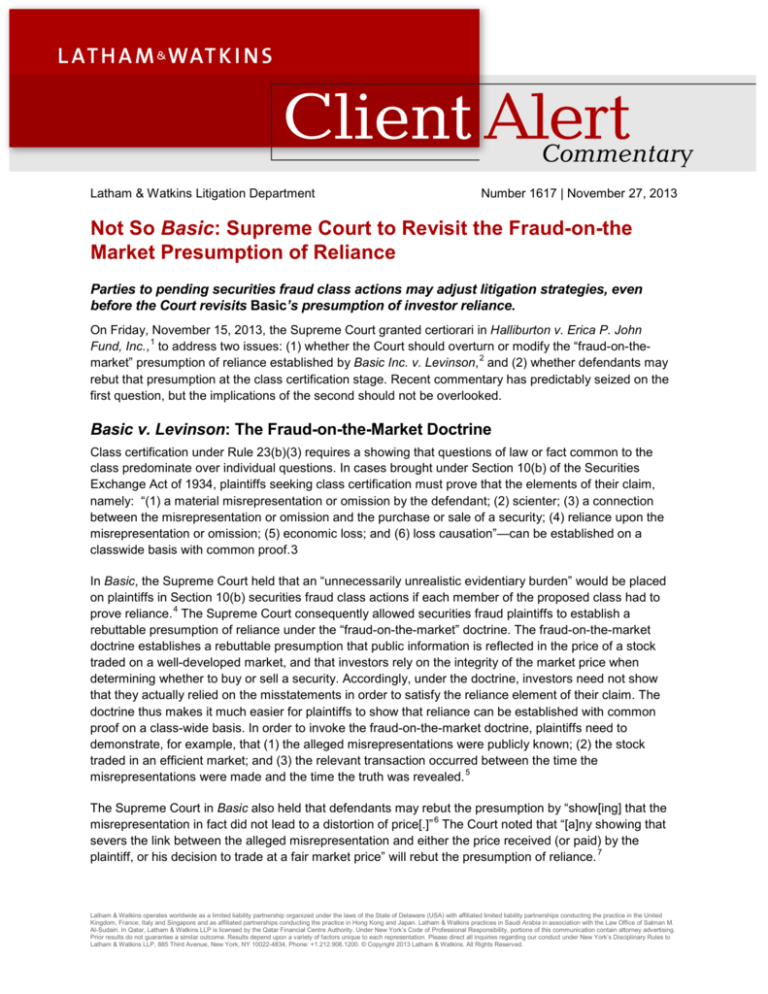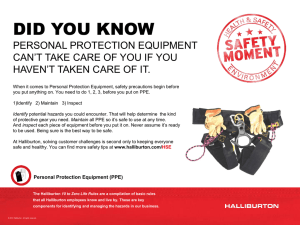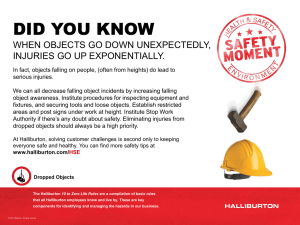
Latham & Watkins Litigation Department Number 1617 | November 27, 2013 Not So Basic: Supreme Court to Revisit the Fraud-­on-­the Market Presumption of Reliance Parties to pending securities fraud class actions may adjust litigation strategies, even before the Court revisits Basic’s presumption of investor reliance. On Friday, November 15, 2013, the Supreme Court granted certiorari in Halliburton v. Erica P. John 1
Fund, Inc., to address two issues: (1) whether the Court should overturn or modify the “fraud-­on-­the-­
2
market” presumption of reliance established by Basic Inc. v. Levinson, and (2) whether defendants may rebut that presumption at the class certification stage. Recent commentary has predictably seized on the first question, but the implications of the second should not be overlooked. Basic v. Levinson: The Fraud-­on-­the-­Market Doctrine Class certification under Rule 23(b)(3) requires a showing that questions of law or fact common to the class predominate over individual questions. In cases brought under Section 10(b) of the Securities Exchange Act of 1934, plaintiffs seeking class certification must prove that the elements of their claim, namely: “(1) a material misrepresentation or omission by the defendant;; (2) scienter;; (3) a connection between the misrepresentation or omission and the purchase or sale of a security;; (4) reliance upon the misrepresentation or omission;; (5) economic loss;; and (6) loss causation”—can be established on a classwide basis with common proof.3 In Basic, the Supreme Court held that an “unnecessarily unrealistic evidentiary burden” would be placed on plaintiffs in Section 10(b) securities fraud class actions if each member of the proposed class had to 4
prove reliance. The Supreme Court consequently allowed securities fraud plaintiffs to establish a rebuttable presumption of reliance under the “fraud-­on-­the-­market” doctrine. The fraud-­on-­the-­market doctrine establishes a rebuttable presumption that public information is reflected in the price of a stock traded on a well-­developed market, and that investors rely on the integrity of the market price when determining whether to buy or sell a security. Accordingly, under the doctrine, investors need not show that they actually relied on the misstatements in order to satisfy the reliance element of their claim. The doctrine thus makes it much easier for plaintiffs to show that reliance can be established with common proof on a class-­wide basis. In order to invoke the fraud-­on-­the-­market doctrine, plaintiffs need to demonstrate, for example, that (1) the alleged misrepresentations were publicly known;; (2) the stock traded in an efficient market;; and (3) the relevant transaction occurred between the time the 5
misrepresentations were made and the time the truth was revealed. The Supreme Court in Basic also held that defendants may rebut the presumption by “show[ing] that the 6
misrepresentation in fact did not lead to a distortion of price[.]” The Court noted that “[a]ny showing that severs the link between the alleged misrepresentation and either the price received (or paid) by the 7
plaintiff, or his decision to trade at a fair market price” will rebut the presumption of reliance. Latham & W atkins operates worldwide as a limited liability partnership organized under the laws of the State of Delaware (USA) with affiliated limited liability partnerships conducting the practice in the United Kingdom, France, Italy and Singapore and as affiliated partnerships conducting the practice in Hong Kong and Japan. Latham & Watkins practices in Saudi Arabia in association with the Law Office of Salman M. Al-­Sudairi. In Qatar, Latham & Watkins LLP is licensed by the Qatar Financial Centre Authority. Under New York’s Code of Professional Responsibility, portions of this communication contain attorney advertising. Prior results do not guarantee a similar outcome. Results depend upon a variety of factors unique to each representation. Please direct all inquiries regarding our conduct under New York’s Disciplinary Rules to Latham & W atkins LLP, 885 Third Avenue, New York, NY 10022-­4834, Phone: +1.212.906.1200. © Copyright 2013 Latham & W atkins. All Rights Reserved. Halliburton I & Amgen Left Open Several Critical Questions The Supreme Court has taken two cases within the past two years in an effort to resolve circuit splits regarding the application and limitations of the fraud-­on-­the-­market doctrine. 8
In Erica P. John Fund, Inc. v. Halliburton (Halliburton I), a unanimous Court held that plaintiffs need not prove loss causation as a precondition to invoking the fraud-­on-­the-­market presumption of reliance. The Court distinguished the fraud-­on-­the-­market presumption as focusing on the stock price “at the time of the relevant transaction,” while loss causation requires proof that the misrepresentation “also caused a 9
subsequent economic loss.” Thus, the Court held that requiring plaintiffs to show loss causation “contravenes Basic’s fundamental premise” and has “no logical connection to the facts necessary to 10
establish the efficient market predicate to the fraud-­on-­the-­market theory.” Notably, Halliburton had conceded that securities fraud plaintiffs need not prove loss causation to apply Basic’s presumption of reliance or otherwise achieve class certification. Instead, Halliburton argued that the Fifth Circuit had not actually required that plaintiffs show loss causation, but rather that plaintiffs show 11
“price impact” (i.e., whether the alleged misrepresentations affected the market price in the first place). But the Court specifically declined to address “Basic, its presumption, or how and when it may be 12
rebutted.” The following Term, in Amgen Inc. v. Connecticut Retirement Plans & Trust Funds, the Court addressed one of the many questions left open in Halliburton I — whether plaintiffs must establish materiality to invoke the fraud-­on-­the-­market presumption. The Court held that although “materiality is an essential predicate of the fraud-­on-­the-­market theory,” materiality need not be established at the class certification stage in order “to ensure that the questions of law or fact common to the class will ‘predominate over any 13
questions affecting only individual members’” under Rule 23(b)(3). First, the Court explained that 14
materiality is an objective question that “can be proved through evidence common to the class.” Second, unlike the market efficiency and publicity predicates of the fraud-­on-­the-­market presumption, 15
materiality is also a substantive element of a Rule 10b-­5 claim. Thus, the failure to prove materiality at the class certification stage would be fatal to the entire class and each individual action, avoiding the risk 16
that individual questions would predominate. Based on this reasoning, the Court further held that defendants cannot offer rebuttal evidence showing 17
that the alleged misstatements were immaterial. Even if defendants could conclusively rebut the fraud-­
on-­the-­market presumption by disproving materiality, proof of immateriality would foreclose all individual 18
claims and create no risk of the predominance of individual issues. The Court stated that, under Basic, whether defendants can rebut the presumption with evidence that “news of the [truth] credibly entered the 19
market and dissipated the effects of [prior] misstatements” is a matter for trial on the merits. Halliburton II: The Fraud-­on-­the-­Market Doctrine Revisited The issues left open in Halliburton I and Amgen were squarely addressed in the Halliburton case on remand. Halliburton argued that the absence of price impact rebuts the fraud-­on-­the-­market presumption because such evidence “shows that the price did not actually transfer the effects of the alleged fraud to a 20
21
stock purchaser.” The district court declined to consider Halliburton’s evidence of no price impact, and 22
the Fifth Circuit likewise refused to embrace Halliburton’s argument. The Fifth Circuit observed that the absence of a price impact may demonstrate that the market did not actually incorporate the alleged fraudulent information into the market price, but the court nevertheless held that, under the “proper analytical framework” set forth in Amgen, common questions still predominate because the measure of a misrepresentation’s impact on the stock price is an objective inquiry that “inherently applies to everyone in 23
the class.” The Fifth Circuit explained that Amgen precludes inquiry into an issue that would resolve a Latham & Watkins Client Alert No. 1617 | November 27, 2013 | Page 2 24
substantive element of a Rule 10b-­5 claim, and that the absence of a price impact was dispositive 25
because if there was no price impact, no individual plaintiff could establish loss causation. Halliburton II tees up for resolution two questions the Court left open in Halliburton I and Amgen: (1) whether the Court should overrule or substantially modify the fraud-­on-­the-­market presumption, and (2) whether defendants may rebut the presumption of reliance at the class certification stage by introducing 26
evidence that the alleged misrepresentations did not impact the market price of the stock. The arguments presented in the parties’ certiorari briefs and the amicus briefs offer a preview of the merits arguments the Court will consider on these issues. Halliburton argues that Basic should be overruled because it depends on the legitimacy of the efficient capital markets theory, which “has been almost universally repudiated” by recent economic research and 27
which lower courts find unworkable in practice. Halliburton further asserts that the Court should modify Basic to require plaintiffs to prove that the alleged misrepresentations actually distorted the stock’s market 28
price. At a minimum, Halliburton contends that the Fifth Circuit’s interpretation of Amgen conflicts with Basic’s assurance that defendants may rebut the presumption of reliance by demonstrating “that the 29
misrepresentation in fact did not lead to a distortion of price.” The Fund’s opposition brief defends the Fifth Circuit’s interpretation of Amgen, arguing that Halliburton I and Amgen preclude Halliburton from introducing price impact evidence to rebut the fraud-­on-­the-­market 30
presumption at class certification. The Fund argues that Halliburton I prevents consideration of price impact as tantamount to loss causation, and Amgen bars consideration of price impact because it is a common, dispositive question. Second, the Fund argues that the Court should preserve its decision in Basic, which neither the Court nor Congress has seen fit to revisit or reconsider in the twenty-­five years 31
since the decision was issued. And third, the Fund contends that the efficient capital markets theory 32
remains widely supported in both congressional policy and economic literature. In a case of this magnitude, unsurprisingly several amicus briefs supported Halliburton’s petition for certiorari. Briefs filed by the US Chamber of Commerce and the National Association of Manufacturers urged the Court to overrule Basic because the fraud-­on-­the-­market presumption is a judicially-­created 33
rule that is no longer supported by a viable economic theory. An amicus brief filed on behalf of DRI – The Voice of the Defense Bar stresses the in terrorem effect of rendering class certification in securities actions a “foregone conclusion.” And former SEC officials and law professors focus on the historical basis for Section 10(b) claims and challenge Basic’s allowance of monetary damages without proof of actual 34
reliance as inconsistent with the genesis of the private right of action for securities fraud. Potential Implications of Halliburton II As the parties’ and amici’s briefing on certiorari indicates, there are as many potential solutions to the Basic problem as there are voices. In the immediate wake of the Court’s order granting certiorari in Halliburton II, commentary focused on the prospect that the Court may overturn Basic and eliminate the fraud-­on-­the-­market presumption of reliance. Securities litigators sounded alarms, arguing that such a decision would be a death knell for private securities class actions. As discussed below, this concern may be overblown, and may overshadow the implications of the Court’s narrower, and likelier, analysis of when and how plaintiffs may assert, and defendants may rebut, the presumption of reliance. Implications of Overturning Basic As recent commentary has emphasized, if the Court uses Halliburton II to invalidate the fraud-­on-­the-­
market presumption of reliance, lead plaintiffs asserting claims of securities fraud under Section 10(b) of 35
the Securities Exchange Act based on alleged misrepresentations likely would no longer be able to Latham & Watkins Client Alert No. 1617 | November 27, 2013 | Page 3 certify investor classes for these claims. Without the presumption of reliance, individual questions of reliance may predominate over class-­wide questions, making class certification inappropriate. But eliminating the presumption of reliance would not be a panacea for securities class action defendants. Even if Basic were overruled and the “fraud-­on-­the-­market” presumption rejected, plaintiffs may still be able to bring a variety of securities class actions. Section 11 of the Securities Act of 1933 Section 11 of the Securities Act of 1933 creates a private right of action to recover damages from certain entities relating to misrepresentations and omissions in registered securities offerings. Under Section 11, any person acquiring a security pursuant to a public offering may sue an issuer’s directors and officers, specialists providing consents, and underwriters in connection with material misstatements or omissions 36
in an issuer’s registration statement or the materials incorporated therein. Reliance is not expressly identified as an element of claims under Section 11. Rather, Section 11 provides certain purchasers — those who acquire securities “after the issuer has made generally available to its security holders an earning statement covering a period of at least twelve months beginning after the effective date of the registration statement” — bear the burden to prove reliance on 37
the alleged misrepresentation or omission. Other purchasers in an offering need not affirmatively prove reliance. These purchasers may thus sustain a class action without the Basic presumption, as to the extent reliance is an element, it is effectively already presumed. Cases Based on “Omissions” In contrast to Section 11, to establish a claim for securities fraud under Section 10(b), a plaintiff must 38
prove reliance on a defendant’s deceptive acts. This reliance requirement applies to both claims based on affirmative misrepresentations and claims based on omissions. But it is understandably difficult for a plaintiff to prove actual reliance on an omission of a material fact. A plaintiff cannot demonstrate that it read and relied on information omitted from a public filing in connection with a purchase or sale of securities. Indeed, the plaintiff’s very inability to rely on the omitted information is the basis for its claim. 39
To address this problem, the Supreme Court in Affiliated Ute Citizens of Utah v. United States recognized a presumption of reliance on an omission of material fact by a party with a duty to disclose that information to the plaintiff. The Affiliated Ute presumption of reliance does not rest on the fraud-­on-­
the-­market theory — articulated in Basic and challenged in Halliburton — and thus may give plaintiffs another path to class certification even if Basic is overruled. Plaintiffs may be incentivized to characterize their claims (whenever possible) as predicated on material omissions, rather than affirmative misrepresentations. The line between misstatements and omissions is hazy. Where a statement is materially misleading because it is incomplete, for example, it often may reasonably be characterized as either a misrepresentation or an omission. For example, assume it rained on Wednesday but was sunny every other day last week, and someone reports, “It was sunny last week.” Is this a misrepresentation because it implies that it was sunny every day and not just six of seven days? Or is it an omission of material fact because the report failed to also acknowledge that it rained on Wednesday? Given the overlap between misstatements and omissions, if reliance may be presumed as to omissions but not misrepresentations, plaintiffs will have an incentive to characterize their Section 10(b) claims as predicated on omissions of material fact rather than affirmative misrepresentations. And the question of whether the alleged deceptive acts are properly characterized as omissions or misrepresentations may take on greater importance at the class certification stage. Latham & Watkins Client Alert No. 1617 | November 27, 2013 | Page 4 A Rebuttable Presumption of Reliance? If the Court does not overrule or substantially modify Basic, the Court’s opinion still may have far-­reaching implications for defendants’ ability to prevent class certification in Section 10(b) cases. The Court in Halliburton I was clear that loss causation is a “distinct concept” from reliance and that loss 40
causation need not be established by plaintiffs at the class certification stage. However, the Court expressly did not decide whether price-­impact evidence similar to that used in a loss causation analysis 41
could be used to rebut the fraud-­on-­the-­market presumption. In other words, the Court did not determine whether a showing by defendants at the class certification stage of an absence of “back-­end” movement — i.e., no stock-­price decline caused by a corrective disclosure — could rebut the fraud-­on-­the-­market presumption. Nor did the Court decide whether a showing of no “front-­end” price impact — i.e., a material price increase at the time when the alleged misstatement was made — could rebut the presumption of reliance. Although the Court did not directly address this issue in Halliburton I, the opinion at least suggests that “front-­end” price impact is required for the fraud-­on-­the-­market presumption to apply. As the Court stated then, “[u]nder Basic’s fraud-­on-­the-­market doctrine, an investor presumptively relies on a defendant’s misrepresentation if that ‘information is reflected in [the] market price’ of the stock at the time of the 42
relevant transaction.” This language — and the notion that the absence of price impact could rebut the 43
presumption of reliance — is consistent with the pre-­Amgen views of the Second and Third Circuits. A key question the Court will confront in Halliburton II is whether the Court’s Amgen opinion forecloses examination of price impact at the class certification stage given its dispositive impact on loss causation — a substantive element of a Section 10(b) claim. If the Court decides that defendants may rebut the presumption of reliance by proof that the alleged misstatements had no impact on a company’s stock price, it will likely be more difficult for plaintiffs to use the fraud-­on-­the-­market presumption of reliance to certify investor classes. The immediate effect may be more, not less, litigation going forward, as courts grapple with the application of such a framework in particular cases. Longer term, such a decision may have the effect of reducing the number of Section 10(b) class action cases brought as plaintiffs choose not to bring cases vulnerable to price-­impact rebuttal. Halliburton II’s Impact on Pending Cases Although the Court will not resolve the issues presented in Halliburton II until the spring or early summer of 2014, concerns about the possible outcome may impact pending securities fraud class actions. Where plaintiffs have not yet moved to certify a class or a class certification motion is pending, the uncertainty in the law may have an immediate impact on settlement. Plaintiffs may be more likely to seek early settlement particularly where evidence suggests no price impact. Defendants may be able to take advantage of the Court’s apparent willingness to constrain or overrule Basic by insisting on more favorable settlement terms. If the Supreme Court ultimately modifies or overrules Basic, defendants in pending cases may move to decertify a previously-­certified class on the basis that the class no longer meets the predominance 44
requirement of Rule 23(b)(3). The standard for decertifying a class varies by jurisdiction, but the change in law may constitute a compelling reason to justify decertification if Halliburton II is inconsistent with the 45
district court’s prior order. Until the Court issues its decision, parties currently embroiled in Section 10(b) securities litigation would be wise to conduct discovery with a heightened focus on evidence that would be relevant to proving or rebutting the presumption. Latham & Watkins Client Alert No. 1617 | November 27, 2013 | Page 5 If you have questions about this Client Alert, please contact one of the authors listed below or the Latham lawyer with whom you normally consult: Lori Alvino McGill lori.alvino.mcgill @lw.com +1.202.637.2319 Washington, D.C. Kevin Metz kevin.metz @lw.com +1.202.637.2338 Washington, D.C. Christopher S. Turner christopher.turner @lw.com +1.202.637.2127 Washington, D.C. Colleen C. Smith colleen.smith@lw.com +1.619.238.2950 San Diego Client Alert is published by Latham & Watkins as a news reporting service to clients and other friends. The information contained in this publication should not be construed as legal advice. Should further analysis or explanation of the subject matter be required, please contact the lawyer with whom you normally consult. A complete list of Latham’s Client Alerts can be found at www.lw.com. If you wish to update your contact details or customize the information you receive from Latham & Watkins, visit http://events.lw.com/reaction/subscriptionpage.html to subscribe to the firm’s global client mailings program. Endnotes 1
Halliburton Co. v. Erica P. John Fund, Inc., No. 13-­317, 82 U.S.L.W. 3119 (U.S. Nov. 15, 2013). 2 485 U.S. 224, 243–50 (1988). 3 Matrixx Initiatives, Inc. v. Siracusano, 131 S. Ct. 1309, 1317 (2011). 4
485 U.S. at 245. 5 Erica P. John Fund, Inc. v. Halliburton Co., 131 S. Ct. 2179, 2185 (2011) (quoting Basic, 485 U.S. at 248 n.27). 6 485 U.S. at 248. 7 Id. 8 131 S. Ct. 2179, 2187 (2011). 9 Id. at 2186 (emphasis in original). 10 Id. 11 Id. at 2182–87. 12
Id at 2187. 13 Amgen Inc. v. Conn. Ret. Plans & Trust Funds, 133 S. Ct. 1184, 1195 (2013) (emphasis in original) (quoting Fed. R. Civ. P. 23(b)(3)). 14 Id. Latham & Watkins Client Alert No. 1617 | November 27, 2013 | Page 6 15 Id. at 1196, 1199;; see also id. at 1198–99 (distinguishing the trade-­timing predicate on the basis that it relates to the Rule 23(a) requirements of typicality and adequacy of representation, not Rule 23(b)(3)). 16
Id. at 1196. 17 Id. at 1203–04. 18
Id. at 1204. 19
Id. (quoting Basic Inc. v. Levinson, 485 U.S. 224, 248–49 (1988)). 20
Erica P. John Fund, Inc. v. Halliburton Co., 718 F.3d 423, 433 (5th Cir. 2013), cert. granted, 82 U.S.L.W. 3119 (U.S. Nov. 15, 2013) (No. 13-­317). 21 Archdiocese of Milwaukee Supporting Fund, Inc. v. Halliburton Co., No. 3:02CV1152M, 2012 U.S. Dist. LEXIS 24823, at *14–
15, (N.D. Tex. Jan. 27, 2012), aff'd sub nom. Erica P. John Fund, Inc. v. Halliburton Co., 718 F.3d 423 (5th Cir. 2013), cert. granted, 82 U.S.L.W. 3119 (U.S. Nov. 15, 2013) (No. 13-­317). 22
Halliburton, 718 F.3d at 432–35. 23 Id. at 433. 24 See id. at 432, 434. 25
Id. at 434. 26 Halliburton Co. v. Erica P. John Fund, Inc., No. 13-­317, 82 U.S.L.W. 3119 (U.S. Nov. 15, 2013);; see Petition for Writ of Certiorari, at i, Halliburton Co. v. Erica P. John Fund, Inc., 82 U.S.L.W. 3119 (U.S. Nov. 15, 2013) (No. 13-­317) [hereinafter Petition for Writ of Certiorari]. 27 Petition for Writ of Certiorari, supra note 26, at 12;; see Halliburton, 718 F.3d at 430–33. 28 Petition for Writ of Certiorari, supra note 26, at 3. 29 Id. at 6 (quoting Basic Inc. v. Levinson, 485 U.S. 224, 248 (1988)). 30 Brief for Respondent in Opposition to Petition for Writ of Certiorari at 16–20, Halliburton Co. v. Erica P. John Fund, Inc., 82 U.S.L.W. 3119 (U.S. Nov. 15, 2013) (No. 13-­317). 31 Id. at 31–32. 32
Id. at 37–39. 33 Brief for Chamber of Commerce of the United States et al. as Amici Curiae in Support of Petitioners at 2–4, Halliburton Co. v. Erica P. John Fund, Inc., 82 U.S.L.W. 3119 (U.S. Nov. 15, 2013) (No. 13-­317). 34
Id. at 6–8. 35 15 U.S.C. § 78j(b) (2012). 36
Id. § 77k(a). 37
Id. 38
Id. § 78j(b);; 17 C.F.R. § 240.10b-­5 (2013). 39
406 U.S. 128, 152–53 (1972). 40
See Erica P. John Fund, Inc. v. Halliburton Co., 131 S. Ct. 2179, 2186 (2011) (“[T]he fact that a subsequent loss may have been caused by factors other than the revelation of a misrepresentation has nothing to do with whether an investor relied on the misrepresentation in the first place, either directly or presumptively through the fraud-­on-­the-­market theory.”) (emphasis added). 41
See id. at 2187 (“As we have explained, loss causation . . . is not price impact.”). 42
Id. at 2186 (emphasis added). 43
In re DVI, Inc. Sec. Litig., 639 F.3d 623, 638–39 (3d Cir. 2011) (“But evidence introduced by a defendant at the class certification stage demonstrating an allegedly corrective disclosure did not move the market—that there was no market impact and therefore no loss causation—may in some circumstances rebut the presumption of reliance and in turn defeat predominance.”);; In re Salomon Analyst Metromedia Litig., 544 F.3d 474, 484 (2d Cir. 2008) (noting that a defendant “is allowed to rebut the presumption, prior to class certification, by showing . . . the absence of a price impact”);; see also In re Moody’s Corp. Sec. Litig., 274 F.R.D. 480, 490 (S.D.N.Y. 2011) (“[A] showing that there was no price decrease when the misrepresentations were disclosed is evidence that the stock price was not artificially inflated by the introduction of the misrepresentation in the market.”). 44 See Fed. R. Civ. P. 23(c)(1). 45 See, e.g., Doe v. Karadzic, 192 F.R.D. 133, 136–37 (S.D.N.Y. 2000) (agreeing to reconsider prior order granting class certification where subsequent Supreme Court authority affected the underlying rationale of certification). Latham & Watkins Client Alert No. 1617 | November 27, 2013 | Page 7







